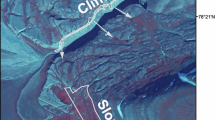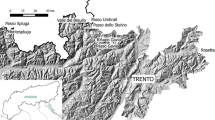Abstract
We examined basic breeding biology, as well as the effects of parental sex, brood size, nestling age, and nest habitat on foraging distances and parental food delivery rates of snow buntings (Plectrophenax nivalis) on Devon Island, NT, Canada, in the summers of 2003–2006. Clutch sizes and initiation dates were similar to those found in previous studies, although nest density was much higher. Feeding rates and foraging distances of buntings differed depending on the size and age of the brood, but were similar between nest habitats. Unlike in earlier studies, we found that male buntings made fewer feeding visits, but traveled longer distances to forage for food than females. Whether these differences between the sexes relate to reducing competition for prey, or to differing sex roles in parental care due to the poorly insulated nest cavities of this species, remains to be determined.



Similar content being viewed by others
References
Blais JM, Kimpe LE, McMahon D, Keatley BE, Mallory ML, Douglas MSV, Smol JP (2005) Arctic seabirds transport marine-derived contaminants. Science 309:445
Carey M (1990) The effects of brood size and nestling age on the parental care by male Field Sparrows (Spizella pusilla). Auk 107:580–586
Carlson A, Moreno J (1992) Costs of short flights in the Willow Tit measured with doubly-labeled water. Auk 109:389–393
Clutton-Brock T (1991) The evolution of parental care. Princeton University Press, Princeton
Drent RH, Daan S (1980) The prudent parent: energetic adjustments in avian breeding. Ardea 68:225–252
Grieco F (2002) Time constraint on food choice in provisioning blue tits, Parus caeruleus: the relationship between feeding rate and prey size. Anim Behav 63:517–526
Grundel R (1987) Determinants of nestling feeding rates and parental investment in the mountain chickadee. Condor 89:319–328
Hoftstad E, Espmark E, Moksnes A, Haugan T, Ingebrigtsen M (2002) The relationship between song performance and male quality in snow buntings (Plectrophenax nivalis). Can J Zool 80:524–531
Hoset KS, Espmark Y, Moksnes A, Haugan A, Ingebrigsten M, Lier M (2004) Effects of ambient temperature on food provisioning and reproductive success in snow buntings (Plectrophenax nivalis) in the high arctic. Ardea 92:239–246
Hussell DJT (1972) Factors affecting clutch size in arctic passerines. Ecol Monogr 42:317–364
Hussell DJT, Holroyd G (1974) Birds of the Truelove Lowland and the adjacent areas of northeastern Devon Island. Can Field Nat 88:197–212
Lack D (1968) Ecological adaptations for breeding birds. Methuen, London
Lyon BE, Montgomerie RD (1985) Incubation feeding in snow buntings: female manipulation or indirect male parental care? Behav Ecol Sociobiol 17:279–284
Lyon BE, Montgomerie RD (1987) Ecological correlates of incubation feeding: a comparative study of high arctic finches. Ecology 68:713–722
Lyon B, Montgomerie R (1995) Snow bunting and McKay’s bunting (Plectrophenax nivalis and Plectrophenax hyperboreus). In: Poole A, Gill F (eds) The birds of North America, no 198–199. The Birds of North America Inc, Philadelphia
Lyon BE, Montgomerie RD, Hamilton LD (1987) Male parental care and monogamy in snow buntings. Behav Ecol Sociobiol 20:377–382
Maher WJ (1964) Growth rate and development of endothermy in the snow bunting (Plectrophenax nivalis) and Lapland longspur (Calcarius lapponicus) at Barrow, Alaska. Ecology 45:520–529
Montgomerie RD, Cartar RV, McLaughlin RV, Lyon B (1983) Birds of Sarcpa Lake, Melville Peninsula, Northwest Territories: breeding phenologies, densities and biogeography. Arctic 36:65–75
Moreno J (1987) Parental care in the wheatear Oenantheo enanthe: effects of nestling age and brood size. Ornis Scand 18:291–301
Orians GJ, Pearson NE (1979) On the theory of central place foraging. In: Horn DJ, Mitchell RD, Stairs GR (eds) An analysis of ecological systems. Ohio State University Press, Columbus, pp 155–177
Pattie DL (1977) Population levels and bioenergetics of arctic birds on Truelove Lowlands. In: Bliss LC (ed) Truelove Lowland, Devon Island, Canada. University of Alberta Press, Edmonton, pp 413–436
Rauter CM, Brodmann PD, Reyer HU (2000) Provisioning behaviour in relation to food availability and nestling food demand in the Water Pipit Anthus spinoletta. Ardea 88:81–90
Ricklefs RE (1974) Energetics of reproduction in birds. In: Paynter RA (ed) Avian energetics. Nuttall Ornithological Club, Cambridge, pp 152–297
Robins JD (1971) Differential niche utilization in a grassland sparrow. Ecology 52:1065–1070
Sejberg D, Bensch S, Hasselquist D (2000) Nestling provisioning in polygynous great reed warblers (Acrocephalus arundinaceus): do males bring larger prey to compensate for fewer nest visits? Behav Ecol Sociobiol 47:213–219
Selander RK (1966) Sexual dimorphism and differential niche utilization in birds. Condor 68:113–151
Smith RD, Marquiss M (1995) Production and costs of nesting attempts in snow buntings (Plectrophenax nivalis): why do they attempt second broods? Ibis 137:469–476
Statsoft Inc (2004) Statistica for Windows 7.0. Statsoft Inc., Tulsa
Stauss MJ, Burkhardt JF, Tomiuk J (2005) Foraging flight distances as a measure of parental effort in blue tits Parus caeruleus differ with environmental conditions. J Avian Biol 36:47–56
Trivers R (1972) Parental investment and sexual selection. In: Campbell B (ed) Sexual selection and the descent of man. Aldine Press, Chicago, pp 136–179
Wesolowski T (1994) On the origin of parental care and the early evolution of male and female parental roles in birds. Am Nat 143:39–58
Wright J, Booth C, Cotton PA, Bryant D (1998) Quality vs quantity: energetic and nutritional trade-offs in parental provisioning strategies. J Anim Ecol 67:620–634
Acknowledgments
We thank J. Akearok, R. Bryan, D. Copplestone, B. Walters and J. McConnell for assistance with aspects of the project, and especially to D. Edwards, A. Fontaine, and R. Ludkin for data collection in 2003–2005. Two anonymous referees and D.J.T. Hussell provided insightful reviews of the paper. This research was made possible by financial or logistic support from Environment Canada (CWS), Natural Resources Canada (PCSP), and Trent University.
Author information
Authors and Affiliations
Corresponding author
Rights and permissions
About this article
Cite this article
Falconer, C.M., Mallory, M.L. & Nol, E. Breeding biology and provisioning of nestling snow buntings in the Canadian High Arctic. Polar Biol 31, 483–489 (2008). https://doi.org/10.1007/s00300-007-0374-z
Received:
Revised:
Accepted:
Published:
Issue Date:
DOI: https://doi.org/10.1007/s00300-007-0374-z




